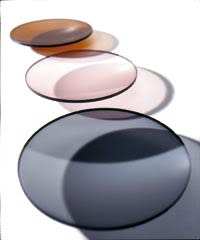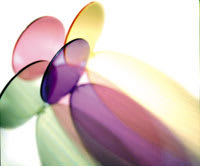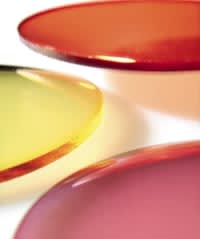|
|
|
|
Lenses in these photos supplied by Younger Optics, Transitions Splitz, and Solera by Invicta Vision. |
Color Me Beautiful�and Practical
Matching lens colors and materials to your patients' activities
By Joseph L. Bruneni
Photography by Peter Baker
Offering patients the practical advantages of prescription sunwear is routine with experienced dispensers. They discuss it with most patients because they know that prescription sunwear is a service that consumers appreciate, particularly those who have never enjoyed their benefits before.
In some offices, the refractionist will make the dispenser's task even easier by writing a second prescription for sunglasses following the refraction. When doctors take the time to do this, closing a sale for prescription sunwear is easier and faster for the dispensing staff.
There's another reason why experienced dispensers enjoy helping patients choose prescription sunwear. No aspect of dispensing eyewear provides eyecare professionals with so many opportunities for creating distinctive high performance eyewear. The information that follows reviews the many options dispensers have at their fingertips as they design prescription sunwear.
Before the frame is selected, designing custom sunglasses for the patient's individual lifestyle includes three important components: Lens color, lens enhancements, and lens material. Let's review each in depth.
Early Colored Lenses
Oddly enough, the first use of colored lenses was for therapeutic reasons, not to enhance vision. In the early days of eyeglass history (1300AD- 1700AD), the Chinese believed that colored lenses could improve or augment the health of the wearer. Many ancient Chinese eyeglasses found in antique eyewear collections have non-corrective lenses made of colored rock crystal. During the years prior to the 18th century, spectacles in China denoted persons of authority, and their glasses usually featured tinted lenses.
During the early 19th century, blue, pink, and green glass lenses came into use, and popular belief held that there were certain health benefits from wearing them.
It was only in the early 1900s that a scientific approach to color took place. A prominent British scientist named William Crookes developed a carefully chosen lens color to filter out infrared rays, which he believed were harmful to the eyes. This color came to be known by the inventor's name and was called "Crookes" lenses. Color was added to glass in the molten state, producing a cool blue/gray shade that was effective in blocking infrared light. Unfortunately, the color tended to give wearers a rather ghastly look, casting unattractive shadows beneath the eyes.
American Optical added Crookes tinted lenses to its lens line, but AO's chief scientist, Edgar Tillyer, searched for a more pleasing color. He developed an attractive pink shade he called "Cruxite" (an adaptation of the Crookes name). Between the two World Wars, pink lenses in a variety of shades were popular. In fact, during the glory days of glass lenses, more pink lenses were dispensed than clear lenses. During that 50-year period between 1925 and 1975, pink lenses were routinely recommended to patients for a variety of reasons, ranging from "Pink lenses eliminate glare from electric lights" to "Pink adds pleasing color to your skin tones."
As plastic lenses became more accepted, the eyecare professions discovered the allure (and profits) made possible by offering tinted lenses to eyewear consumers. Before long, lenses tinted in a wide variety of colors became the norm. The use of tinted lenses had little if anything to do with vision. Colors were chosen primarily for their cosmetic appeal, with little consideration given to how the color might affect vision.
For sunglasses, green was the basic color in the United States until, during World War II, Bausch & Lomb and American Optical developed gray sun lenses for the U.S. Air Force. Sometime after the war, AO added brown lenses to its sunglass line.

|
|
|
|
Today's Sunwear
Today a curious situation exists-in the United States, gray is by far the preferred color for sunglasses. In Europe and much of the rest of the world, brown is more popular than gray.
Despite overall trends, today's experienced dispensers are using color more selectively than before and choose color for sun lenses based on how the color will affect the wearer's vision. Here's a review of how lens colors can be selectively chosen to enhance vision.
The wide range of color choices provides the opportunity to design sunwear that is exactly right for each patient's lifestyle and enables dispensers to distinguish their service from run-of-the-mill offices.
Gray Tints. For sunwear, gray is still the most popular and is usually a good choice simply because it provides the most neutral sunlens. Gray is the color to recommend when balanced color is important. Gray maintains an even balance throughout the color spectrum, and this can be important to, among others, artists, and gardeners.
Brown Tints. When there is need to increase visual contrast, brown may be a better choice than gray. Through brown lenses, shades of blue are reduced while greens become more predominant. Brown makes a good sunglass for anyone who spends a lot of time driving. With improved contrast, brown lenses provide a slightly better sense of the road surface.
Green Tints. Much like brown, green provides improved contrast over gray without too much shifting of the color balance.
Yellow Tints. When patients are most concerned about enhancing contrast between colors without much reduction of visible light, yellow is a good choice. Yellow lenses are not particularly attractive in appearance but many people like the look because they provide a "sporty" appearance. Yellow is the preferred color for shooters, racing car drivers, golfers (on overcast days), and anyone who wants increased contrast without much reduction of visible light.
Blue Blocking Tints. Sunglasses with blue-blocking lenses were popular for a time but most practitioners do not accept the premise of totally blocking blue light. They believe it alters color perception and can be dangerous under certain conditions.
Golf Tints. On bright sunny days, brown would be the preferred choice for golfers since this color enhances contrast. For overcast days, yellow is a better choice because it doesn't reduce as much visible light. Both brown and yellow enable the ball to be seen easier, in the air and on the ground. Yellow, and brown to some extent, enables golfers to see contours of the course and read the greens better. Here's another advantage of sunglasses for golfers that many golfers fail to realize. When golfers squint, as they tend to do without sunglasses, the very act of squinting tightens the upper body. This, in turn, can inhibit the golf swing. Keeping face muscles relaxed can actually help golfers maintain a relaxed, fluid swing. Discuss this with a golfer and you'll have his or her full attention. Dedicated golfers will not balk at ordering two pair, one in brown for bright days and one in yellow for overcast days.
Tennis Tints. Here, as with golf, enhancing contrast is the primary consideration. For sunglasses, brown would be the most suitable color but amber or yellow tinted glasses for playing indoors or on overcast days should improve the player's performance. Much like golfers, tennis enthusiasts should also be offered two pairs of sports-use glasses, one for sunny days and one for overcast days. True sport fanatics spend enormous sums on special shoes, special clubs, or even special clothing to enhance their game yet there are few things a player can do to increase performance more than enhancing their visual acuity.
|
Tints for Indoors |
|
|
Working under fluorescent lighting can create a certain amount of annoying overhead glare for some people. For them, dispensers can utilize a useful trick of applying a very light pink gradient tint to plastic lenses. The pink gradient color covers no more than the top one-fourth of the lens. An AR coating is then applied to the lenses. The AR increases visible light transmission throughout the lens, leaving just enough color to dull the overhead glare from fluorescent lighting. It's a clever trick that works well and adds a fine cosmetic touch as well.
|
Beyond a Tint
Today's dispenser has a vast variety of options that go beyond mere tinting. Here's a look at just a few of the most important considerations.
Photochromic Sun Lenses. Do photochromic lenses have a place in prescription sunwear? Absolutely. In both glass and plastic, there are special photochromic tints for sun use. Corning offers PhotoSun and Thin & Dark, and Transitions has an XtraActive tint to provide full protection in the sun. None of these turns completely clear indoors, but this may not be problem for sports use. Conventional photochromic lenses can also be used with flash mirror coatings for sports use.
Polarized Sun Lenses. Polarized lenses are rapidly becoming the sunlens of choice for many people. Consumers have learned the advantage of sun lenses that block reflected glare. For this reason, some dispensers always start a discussion of sunglasses with a demonstration of polarized lenses. Once it is determined that the patient wants polarized lenses, the discussion should then turn to choice of color. Fortunately, there is a wide variety of polarized lenses available so color recommendation by the dispenser can follow the suggestions listed above.
Anti-reflective Coating. As a rule, the basic function of sunwear is to reduce the amount of visible light reaching the eye, so applying an AR coating to a sun lens may seem somewhat redundant. In fact, judicious use of an anti-reflection coating can be the frosting on the cake for prescription sunglasses. With any darker tint, the backside of a lens becomes a mirror, reflecting light from the side with annoying shifting reflections into the wearer's eyes. This is why most brand name plano sunglasses feature AR coating on the back surfaces. Whether the sunglasses are for sports use or general wear, the addition of backside AR is an enhancement every wearer will appreciate.
Explain the reasons for this improvement when you recommend backside AR to the patient. Some offices routinely include the cost of backside AR in their sunlens fee, finding this makes it more palatable to patients.
Mirror Coatings. Here is an area where dispensers can provide special benefits to a sun lens. For instance, for any activity in the sun, the addition of a flash gradient mirror on the front surface provides the wearer with the equivalent of a sun visor, much like the gradient darkening found on many automobile windshields. Looking straight ahead, the sun lens functions as normal. The gradient flash mirror coating on the top 25 percent of the lens, however, blocks most overhead light and glare coming from the sky. It provides a comforting "awning" for the eyes. Unlike full-mirrored sunglasses, the lenses don't have that "highway patrolman" appearance and most people enjoy the custom look it gives their sunwear.
Lens Materials
Here the dispenser's choices are somewhat limited, depending on the patient's lifestyle. Many outdoor activities involve potential risk from flying objects or the activities of an active lifestyle, so polycarbonate will be the material of choice in most cases. Poly has a relatively high index (1.59), providing cosmetic advantages to myopes, as well. Lens colors can be applied to any of the available plastic substrates so the choices are unlimited. With glass, colors other than gray or brown often require a color coating, but even here, there is a range of choices available. Color is applied to glass as a thin film coating, similar to the application of AR.
Look at it this way: Many dispensers approach a discussion of sunwear by simply asking, "What color lenses would you like in your sunglasses-gray or brown?" Instead of this uninspired approach, take time to inquire how the patient will be using their sunglasses (hopefully, your office uses a lifestyle questionnaire).
Determining the patient's lifestyle and basing your sunwear recommendation on their patient's specific needs is a more technical approach and provides a real edge over the competition. It's a sure-fire way to impress patients, even those who decide not to order sunwear. You'll find that some of those will come back to order the following season because they were impressed with your explanation of personalized sunwear. EB





